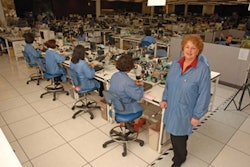
Collaboration is as hot a topic today in the supply chain as ever. And for good reason. With ever greater amounts of value being generated outside the four walls of the enterprise, building and maintaining close relationships with suppliers is becoming a strategic imperative.
While the range of technologies being applied to collaboration includes supplier performance management, supplier risk management, B2B connectivity and supply chain visibility solutions, one set of technologies that has been drawing increasing attention encompasses what is typically called "telepresence."
In practical terms, when people think of telepresence today, they envision a conference room equipped with high-definition video and high-quality audio gear that allows meeting participants to feel like they're in the same room as fellow participants sitting in a similarly equipped room at a different location, possibly a world away.
I spoke recently with John Paul Williams, the energy and manufacturing practice leader at telepresence solution provider TANDBERG (now part of Cisco), about the role of the technology in supply chain collaboration. Williams has been with TANDBERG for more than five years, but previously he spent 25 years managing manufacturing plants in Europe, the US and Asia. Early in his career he worked with Shigeo Shingo, so he is steeped in Lean, and today he preaches the applicability of telepresence to Lean manufacturing.
Williams offered examples of how companies in various sectors are using telepresence at different points in their supply chains:
- A major aerospace manufacturer used telepresence technologies to link a plant that had sustained wind and flood damage with another supplier facility, in a different part of the world, that was tasked with replacing capacity lost at the damaged facility. The company took video directly to the floor of the afflicted plant to show the staff at the new facility how the manufacturing process worked. That allowed the new plant to get up and running quickly and ensured that the new supplier was able to meet requirements and conform to specifications.
- A leading consumer products manufacturer has used telepresence to train personnel at plants within emerging markets. The company linked experts at home with local staff that would be building product, allowing them to compare and contrast processes with an existing best practice plant. Once the plant was up and running, the company used video to connect the new plant to engineers back home to allow for inspections of product coming off the line, problem-solving when issues arose, and process audits.
Williams says that companies typically justify initial investments in telepresence by pointing to reductions in travel expenses — the cost, for example, of sending a team of engineers to a new plant to fix a problem that could have been handled via a video feed. "But once companies gain experience rolling this out," he adds, "the impact on core processes is really quite significant" as users discover new ways to use the technologies.
Williams argues that no real technical barriers to broad adoption of telepresence remain and that the barriers today are more social in nature, for example, getting suppliers to invest in the necessary gear, or simply getting people used to the idea of being "live" on video. But he believes that telepresence will only see further adoption as companies realize the benefits, ultimately fundamentally changing the way that we all live and work. Concludes Williams: "This will have a profound effect on work environments as time goes on. The idea of 'going to work' will become weaker and weaker, where work is a thing you do, not a place you go."
Are you leveraging telepresence in your supply chain, or using other technologies to enable more effective collaboration with your suppliers and customers? Drop me a line at [email protected] and share your thoughts. I'll look forward to hearing from you.
















